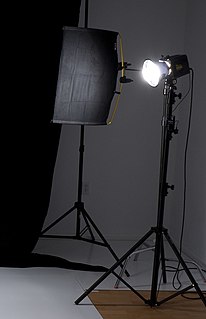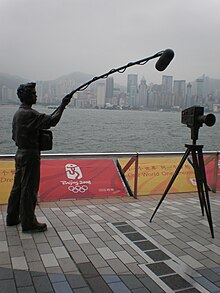
A film crew is a group of people, hired by a production company, for the purpose of producing a film or motion picture. The crew is distinguished from the cast, as the cast are understood to be the actors who appear in front of the camera or provide voices for characters in the film. The crew is also separate from the producers, as the producers are the ones who own a portion of either the film studio or the film's intellectual property rights. A film crew is divided into different departments, each of which specializes in a specific aspect of the production. Film crew positions have evolved over the years, spurred by technological change, but many traditional jobs date from the early 20th century and are common across jurisdictions and filmmaking cultures.
The film industry is built upon many technologies and techniques, drawing upon photography, stagecraft, music, and many other disciplines. Following is an index of specific terminology applicable thereto.

Stage lighting is the craft of lighting as it applies to the production of theater, dance, opera, and other performance arts. Several different types of stage lighting instruments are used in this discipline. In addition to basic lighting, modern stage lighting can also include special effects, such as lasers and fog machines. People who work on stage lighting are commonly referred to as lighting technicians or lighting designers.

In lighting for film, theatre and still photography, a cucoloris is a device for casting shadows or silhouettes to produce patterned illumination. It is normally referred to as a cookie or sometimes as a kook or a coo-koo. The cucoloris is used to create a more natural look by breaking up the light from a man-made source. It can be used to simulate movement by passing shadows or light coming through a leafy canopy.
Electrical lighting technicians (ELT), or simply lighting tech, are involved with rigging stage and location sets and controlling artificial, electric lights for art and entertainment venues or in video, television, or film production.
"Below-the-line" is a term derived from the top sheet of a film budget for motion pictures, television programs, industrial films, independent films, student films and documentaries as well as commercials. The "line" in "below-the-line" refers to the separation of production costs between script and story writers, producers, directors, actors, and casting and the rest of the crew, or production team.

In North American filmmaking a key grip is a senior role for an experienced professional on every set. Their responsibilities are extensive and range from supervising grip crews, assessing what equipment is necessary for each shooting location, coordinating the transportation of this equipment and its set up, arranging the general movement and positioning of the camera and collaborating with the director of photography. The key grip relies on the best boy as their foreperson to supervise the grip crew.

In cinematography, the dolly grip is a dedicated technician trained to operate the camera dolly. This technician places, levels, and moves the dolly track, then pushes and pulls the dolly and usually a camera operator and camera assistant as riders. If the dolly has a moveable vertical axis, such as a hydraulic arm, then the dolly grip also operates the "boom". If both axes are used simultaneously, this type of dolly shot is known as a compound move.

A gobo is an object placed inside or in front of a light source to control the shape of the emitted light and its shadow.
Television crew positions are derived from those of film crew, but with several differences.

In film production, a C-stand is primarily used to position light modifiers, such as silks, nets, or flags, in front of light sources. The stand is constructed of metal and consists of a collapsible base, two riser columns, and a baby pin on top. In addition, a C-stand typically includes a gobo head and a gobo arm, also known as a grip head and grip arm, which provide the ability to articulate a light modifier without moving the stand itself. The legs of C stands are designed to be nested, so many stands can be placed around a light source.
This article contains a list of cinematic techniques that are divided into categories and briefly described.

Intelligent lighting refers to lighting that has automated or mechanical abilities beyond those of traditional, stationary illumination. Although the most advanced intelligent lights can produce extraordinarily complex effects, the intelligence lies with the human lighting designer, control system programmer, or the lighting operator, rather than the fixture itself. For this reason, intelligent lighting (ILS) is also known as automated lighting, moving lights, moving heads, or simply movers.

Stage lighting instruments are used in stage lighting to illuminate theatrical productions, concerts, and other performances taking place in live performance venues. They are also used to light television studios and sound stages.

In film and television crews, the gaffer or chief lighting technician is the head electrician, responsible for the execution of the lighting plan for a production. The gaffer's assistant is the best boy electric.

A flag is a device used in lighting for motion picture and still photography to block light. It can be used to cast a shadow, provide negative fill, or protect the lens from a flare. Its usage is generally dictated by the director of photography, but the responsibility for placing them can vary by region, usually devolving to either the gaffer and electricians or the key grip and lighting grips.
Articles related to the field of motion pictures include:
Stage lighting accessories are components manufactured for conventional (non-automated) stage lighting instruments. Most conventional fixtures are designed to accept a number of different accessories designed to assist in the modification of the output. These accessories are intended to either provide relatively common functionality not originally provided in a fixture, or to extend the versatility of a lighting instrument by introducing features. Other accessories have been designed to overcome limitations or difficulties some fixtures present in specific applications.
This glossary of motion picture terms is a list of definitions of terms and concepts related to motion pictures, filmmaking, cinematography, and the film industry in general.

















